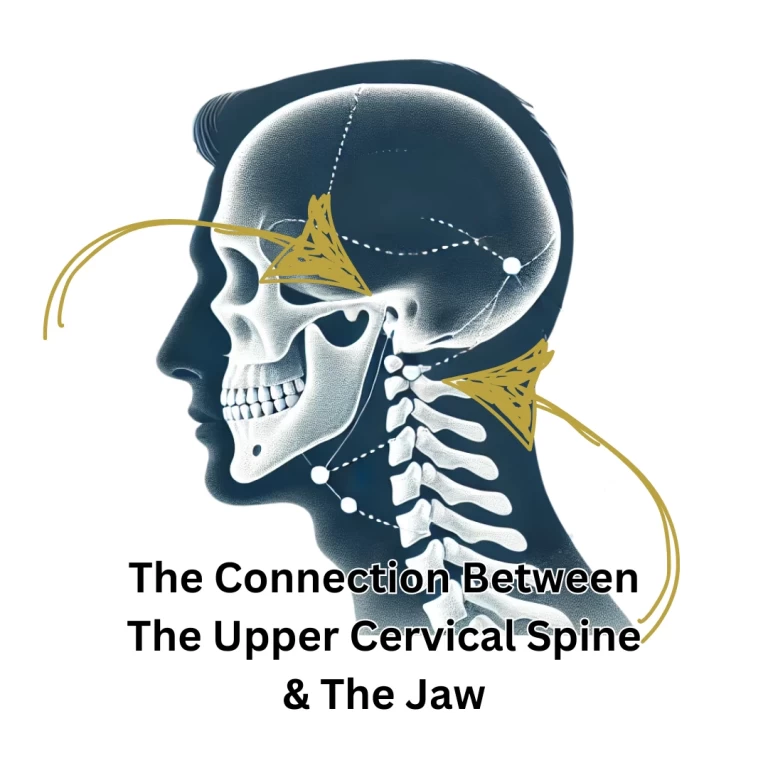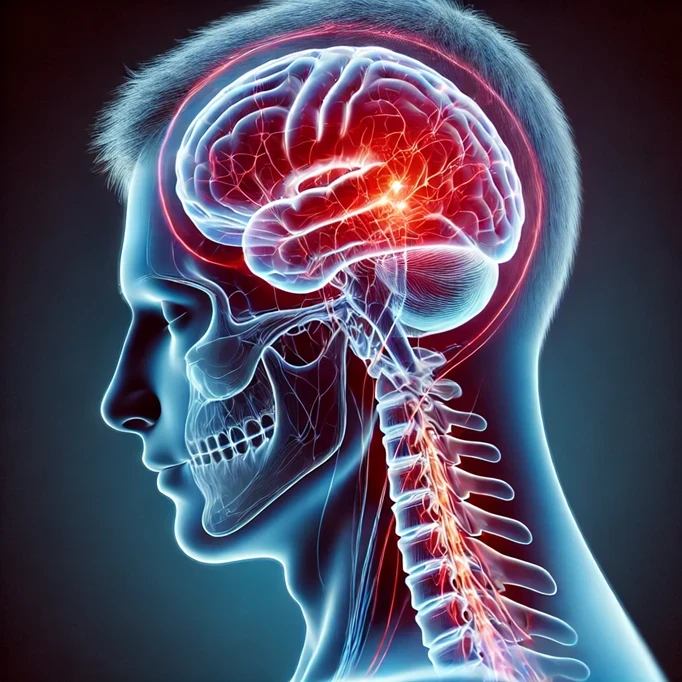
How the Upper Cervical Spine Affects the Jaw: TMJ, TMD, Jaw Dysfunction, and Jaw Pain
When it comes to jaw pain, many people immediately think of dental issues, stress, or nighttime teeth grinding. However, an often-overlooked cause lies in the upper cervical spine, specifically the atlas (C1) and axis (C2) vertebrae. These two vertebrae play a significant role in the alignment and function of the jaw, and any misalignment in this area can contribute to conditions like TMJ (temporomandibular joint dysfunction), TMD (temporomandibular disorders), and persistent jaw pain.
By downloading the Digital Patient Chart mobile app you can better control your patient portal.
This article will explore the connection between the upper cervical spine and the jaw, how misalignments can exacerbate jaw dysfunction, and how upper cervical chiropractic care can address these issues for long-term relief.
Understanding the Anatomy: The Upper Cervical Spine and the Jaw
The upper cervical spine consists of the atlas (C1) and axis (C2), which support the skull, facilitate head movement, and protect the brainstem. These vertebrae play a vital role in maintaining overall spinal alignment and ensuring optimal communication between the brain and body.
The temporomandibular joint (TMJ) connects the lower jaw (mandible) to the skull. This complex joint allows for essential functions like chewing, speaking, and yawning. Proper function of the TMJ depends on balanced muscle activity, healthy nerves, and optimal alignment of surrounding structures—including the upper cervical spine.
When the atlas or axis vertebra becomes misaligned, it can create biomechanical and neurological stress that disrupts TMJ function.
What Are TMJ and TMD?
TMJ dysfunction refers to mechanical issues within the temporomandibular joint, such as improper joint alignment, inflammation, or disc displacement. Meanwhile, TMD (temporomandibular disorders) is an umbrella term for a variety of conditions affecting the TMJ and its associated structures.
Common symptoms of TMD and TMJ dysfunction include:
- Jaw pain or tenderness
- Difficulty opening or closing the mouth
- Clicking, popping, or grinding sounds in the jaw
- Headaches and migraines
- Neck pain or stiffness
- Earaches or ringing in the ears (tinnitus)
While direct trauma to the jaw, stress, or teeth grinding can contribute to TMJ dysfunction, the alignment of the upper cervical spine is often a root cause that goes unnoticed.
The Connection Between the Upper Cervical Spine and the Jaw
The upper cervical spine is intimately connected to the jaw through a network of nerves, muscles, and ligaments. Misalignment in this region can create a ripple effect, impacting jaw alignment and function.
1. Nerve Pathways
The trigeminal nerve, which controls sensation in the face and motor functions of the jaw, is closely related to the upper cervical spine. Misalignment of the atlas can place pressure on the brainstem or associated nerve pathways, leading to jaw dysfunction, TMJ pain, and even chronic headaches.
2. Muscle Tension and Imbalance
Misalignments in the upper cervical spine can cause compensatory muscle tension in the neck, shoulders, and jaw. This muscle imbalance can alter the positioning of the temporomandibular joint, resulting in pain, clicking, or restricted movement.
3. Postural Changes
When the atlas is misaligned, it can shift the head’s position, causing postural imbalances that place additional stress on the jaw. This imbalance often contributes to TMJ dysfunction and exacerbates existing TMD symptoms.
Signs That Your Jaw Pain May Be Linked to Upper Cervical Misalignment
How can you tell if your jaw pain is related to an upper cervical issue? Look for the following signs:
- Persistent TMJ pain despite dental treatments
- Chronic headaches or migraines
- Neck stiffness or limited range of motion
- Unexplained earaches or ringing in the ears
- Facial pain or tingling
- Symptoms that worsen after poor posture or extended sitting
If these symptoms sound familiar, it’s worth consulting an upper cervical chiropractor for a comprehensive evaluation.
How Upper Cervical Chiropractic Care Can Help with TMJ and TMD
Upper cervical chiropractic care focuses on restoring proper alignment of the atlas and axis vertebrae. Unlike traditional chiropractic adjustments, upper cervical care uses precise, gentle techniques tailored to the unique structure of the upper cervical spine.
1. Restoring Atlas Alignment
When the atlas vertebra is misaligned, it can create a domino effect of dysfunction throughout the neck and jaw. Correcting this misalignment can reduce strain on the temporomandibular joint and surrounding muscles, allowing for natural healing.
2. Relieving Nerve Compression
Upper cervical adjustments can alleviate pressure on the brainstem and nerve pathways, including the trigeminal nerve. This can help reduce pain, improve nerve function, and promote better jaw movement.
3. Reducing Muscle Tension
Chronic muscle tension in the neck and shoulders often accompanies TMJ dysfunction. Upper cervical chiropractic care helps relax these muscles by addressing the root cause of the tension—spinal misalignment.
4. Improving Posture
Proper head and neck alignment is crucial for maintaining balanced posture. By correcting upper cervical misalignments, chiropractors can help reduce postural strain on the jaw and prevent future TMJ issues.
Success Stories: The Impact of Upper Cervical Care on Jaw Pain
Patients who have sought upper cervical chiropractic care for TMJ dysfunction or TMD often report significant improvements in pain, jaw function, and overall quality of life. Research has shown that precise atlas adjustments can reduce jaw pain, improve range of motion, and decrease associated symptoms like headaches and neck stiffness.
One study demonstrated that patients with TMJ pain experienced a reduction in symptoms after receiving upper cervical care, highlighting the powerful connection between the atlas vertebra and the temporomandibular joint.
In our office, what we have seen is approximately 85% of jaw related issues resolve or reduce with care. The remaining 15% we recommend follow up with a physical therapist specialized in jaw related conditions. The combination of our care and physical therapy has been highly effective.
What to Expect During Upper Cervical Chiropractic Care
If you decide to explore upper cervical care for jaw pain or dysfunction, here’s what you can expect:
1. Comprehensive Evaluation
Your chiropractor will perform a thorough evaluation, including advanced diagnostic imaging for spinal health, to assess the alignment of your upper cervical spine and its potential impact on your jaw.
2. Personalized Care Plan
Based on your evaluation, a personalized care plan will be developed to address your specific needs.
3. Gentle Adjustments
Upper cervical adjustments are precise, gentle, and non-invasive. These techniques focus on correcting atlas misalignment without the cracking or twisting associated with traditional chiropractic methods.
4. Ongoing Monitoring
Your progress will be closely monitored to ensure lasting relief and optimal jaw function.
Preventing TMJ Dysfunction Through Upper Cervical Health
Preventative care is key to avoiding TMJ dysfunction and TMD. Here are some tips to maintain upper cervical alignment and promote jaw health:
- Practice good posture, especially during work or prolonged sitting.
- Avoid clenching your jaw or grinding your teeth.
- Address neck or back pain promptly with professional care.
- Consider regular chiropractic wellness evaluations to maintain alignment.
Final Thoughts
The connection between the upper cervical spine and the jaw is a critical, yet often overlooked, factor in TMJ dysfunction and TMD. Misalignments in the atlas and axis vertebrae can create muscle tension, nerve irritation, and biomechanical imbalances that lead to chronic jaw pain and dysfunction.
Upper cervical chiropractic care offers a safe, non-invasive solution to address these issues at their source. By restoring proper alignment, relieving nerve pressure, and improving posture, upper cervical care can provide lasting relief from TMJ pain, TMD symptoms, and related jaw dysfunction.
If you’re struggling with persistent jaw pain or dysfunction, consider consulting an upper cervical chiropractor near you. With personalized care and precise adjustments, you can take a proactive step toward improving your quality of life and overall health.







Leave a comment